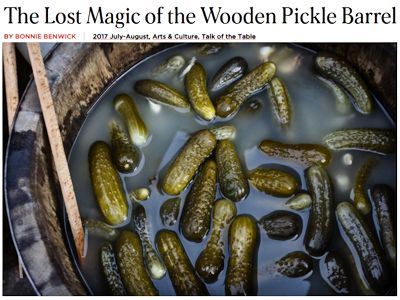History: "Brick
Store" goods (1873)
Contact: Vickie
Surnames: Alden, Aston, Burnell,
Frey
----Source: The
Clark County Press Date: 6-28-1873; Mass Great Outdoors Blog, "History
of Pickling", 11 Augl 2014; HOME / THE CHURNCRAFT JOURNAL History of Butter
Making by Jojo Frey May 19, 2014; Fayetteville History: The Book of Lists--In
1873, Henry L. Burnell printed a small booklet at Fayetteville titled Arkansas:
The Home for Immigrants; a Sketch of Her Resources. The booklet described the
state's attributes, governance and resources. He also included a description of
Fayetteville and included prices of groceries available on several markets in
the state, including the following list of prices on the Fayetteville Grocery
Market:
Brick Store
Stick and fancy
Candies by the box. The Alden Evaporated Apple and Pumpkin, best
pie fruit in use. To Butter makers; We keep the *Aston Salt, Vinegar
Pickles in kits and by the gallon. Dried beef and sugar cured hams.
Mackerel, White-fish and Trout by the half barrel and kit.
*Aston salt was mined in Aston,
PA and was considered comparable to Epsom Salt.
History: Pickle Barrel

Pickling began 4,000 years ago using cucumbers native to
India. Pickling was used as a way to preserve food for out-of-season use and for
long journeys, especially by sea. Pickling and food preservation developed and
grew in the United States during the sixteenth century with the arrival of new
foods from Europe and other parts of the world. Although the process was
invented to preserve foods, today pickled foods are made and enjoyed because
people like the way they taste.
The term pickle is derived from the Dutch word “pekel”, meaning brine. Pickling
is the process of preserving food by anaerobic fermentation in brine or vinegar.
Unlike the canning process, pickling does not require that the food be
completely sterile before it is sealed. Pickling can preserve perishable produce
for months. While vinegar is an essential piece to any pickling project, it does
require some other ingredients, which tend to be the chef’s choice. Often you
will find the use of herbs and spices such as dill weed, garlic, mustard seed,
cinnamon or cloves and most likely a lot of salt.
|
Grocery Prices in
1873 |
Apples .30@ .40
Butter .20 .25
Coffee .26½ .33 1/3
Eggs .10
Fish–Mackerel .15 .20
Fish–Cod .12½
Fish–Cod Kits 2.50 3.00
Fish–Salmon 3.75
Potatoes .50 .60
Rice .13 .16 2/3
Sugar–Brown .13 .16 2/3
Sugar–White .16 .20
Soda .9 .12½
Tea–Green 1.60 2.00
Tea–Black 1.28 1.40
Whisky 2.00 8.00
Flour 4.00 5.00
Sorghum .40 .50
Syrup 1.00 1.25 |
Pork 4.00 7.20
Bacon .10 .15
Nails 7.50 9.00
Salt, per bbl. and lb. 4.00 .3
Canned Peaches .40
Canned Tomatoes .35
Canned Pears .50<
Canned Strawberries .50
Vinegar .25 .50
Coal Oil .60
Soap .8 .10
Tobacco–Plug .65 1.25
Tobacco–Smoking .40 1.60
Candy .20 .50
Crackers .9 .15
Oysters, per doz. cans 1.80 2.85
Oysters, per can .25 .35 |
The tradition of butter making has been around for
thousands of years. From Europe to Africa to South America to Asia, butter has
been a staple of many cultures around the world.
At the beginning, butter making was a rudimentary process. People would fill an
animal skin sack with goat’s milk, since at this time, cows had not yet been
domesticated in most of the world. They would attach the sack to a wooden tripod
with rope and rock it back and forth until it eventually formed butter. Nomadic
peoples would simply hang the sack off the side of a pack animal and butter
would form just through the process of walking.
In time, as with all things, butter making equipment was greatly improved. There
were essentially three types of butter churns: the dash churn, the barrel churn,
and the paddle churn. The dash churn was developed first. It is typically
comprised of a dasher (pole) inserted into the lid of a barrel. The dasher is
moved in a vertical motion, agitating the cream in the barrel.
From the Middle Ages until the Industrial Revolution, dash churns were the most
common device used to make butter. However, the dash churn was eventually
replaced by the barrel churn. A barrel was mounted on wooden legs and had a
crank handle that would rotate the entire barrel. Thereafter, the paddle churn,
which had a crank handle operating a rotating paddle inside the churn, was
popularized for it’s more efficient and less laborious process.
Butter making was an essential chore for every household. Women would spend
hours churning and storing butter for their families, and would often sell to
their neighbors. The art of butter making originated in the home, however, it
was not long until butter making became an industry in it’s own right. As
populations swelled and communities expanded, the need for butter and other
dairy products in urban areas rose.
During the course of the 18th and 19th centuries, butter was commercialized and
widely available for purchase in most countries. Post Industrial Revolution, the
dairy industry in Europe began to boom. Ireland was a primary exporter of
butter, selling mostly to England.
During the 1800s, New York state was the capital of the dairy industry in our
country. The first commercial dairy farm in America was founded in Goshen, NY in
the 1830s. “Goshen Butter” was a thriving industry, until it declined in the mid
1800s due to the development of railroads. Though the butter industry, and the
consumption of butter, has been on a roller coaster in the United States, it is
still one of our nation’s most beloved products.

